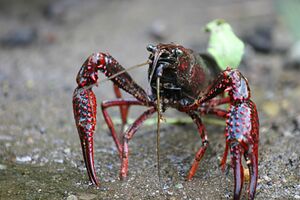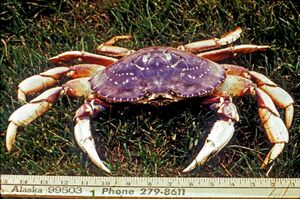قائمة قشريات الولايات الأمريكية
اعتبارا من March 2023[تحديث], seven U.S. states have designated state crustaceans:[1]
- Louisiana has the freshwater crawfish Procambarus clarkii.
- Maryland has the blue crab, Callinectes sapidus.[2]
- Oregon has the Dungeness crab, Metacarcinus magister.[3]
- Alabama has the brown shrimp, Peneaus aztecus.[4]
- Maine has the lobster, Homarus americanus.[5]
- Texas has the Texas Gulf shrimp, Penaeus aztecus, P. setiferus, and P. duorarum.[6]
- Utah has the brine shrimp.[7]
. . . . . . . . . . . . . . . . . . . . . . . . . . . . . . . . . . . . . . . . . . . . . . . . . . . . . . . . . . . . . . . . . . . . . . . . . . . . . . . . . . . . . . . . . . . . . . . . . . . . . . . . . . . . . . . . . . . . . . . . . . . . . . . . . . . . . . . . . . . . . . . . . . . . . . . . . . . . . . . . . . . . . . . .
لويزيانا

In 1983, the state of Louisiana designated the Louisiana crawfish, Procambarus clarkii, as their state crustacean.[8] The native range of P. clarkii is along the Gulf Coast from northern Mexico to the Florida panhandle, as well as inland, to southern Illinois and Ohio.[9] It is most commonly found in warm fresh water, such as slowly flowing rivers, marshes, reservoirs, irrigation systems and rice paddies. P. clarkii grows quickly, and is capable of reaching weights over 50 grams (1.8 oz), and lengths of 5.5–12 centimetres (2.2–4.7 in).[10]
Harvests of P. clarkii account for a large majority of the crawfish produced in the United States. In 1990, Louisiana produced 90% of the crawfish in the world and consumed 70% of it locally,[11] but by 2003, Asian farms and fisheries produced more, outpacing American production rapidly. By 2018, P. clarkii crawfish production in the Americas represented just 4% of total global P. clarkii supply.[12] However, Louisiana crawfish remain in demand locally. In 2018, 93% of crawfish farms in the US were located in Louisiana.[13] Louisiana crawfish are usually boiled in a large pot with heavy seasoning (salt, cayenne pepper, lemon, garlic, bay leaves, etc.) and other items such as potatoes, corn on the cob, onions, garlic, and sausage. There are many differing methods used to season a crawfish boil and an equal number of opinions on which one is correct.[14]
مريلاند

The blue crab, Callinectes sapidus was chosen as the state crustacean of Maryland in 1989.[15] C. sapidus is a crab found in the waters of the western Atlantic Ocean, the Pacific coast of Central America and the Gulf of Mexico. The blue crab may grow to a carapace width of 230 mm (9.1 in). It can be distinguished from a related species that occurs in the same area by the number of frontal teeth on the carapace; C. sapidus has four, while C. ornatus has six.[16]
The Chesapeake Bay, located in Maryland and Virginia, is famous for its blue crabs, and they are one of the most important economic items harvested from it. In 1993, the combined harvest of the blue crabs was valued at around US$100 million. Over the years the population of the blue crab has dropped,[17] and the amount captured has fallen from over 125,000 t (276,000,000 lb) in 1993 to 81,000 t (179,000,000 lb) in 2008.[18] In the Chesapeake Bay, the population fell from 900 million to around 300 million, and capture fell from 52,000 t (115,000,000 lb) in the mid 1990s to 28,000 t (62,000,000 lb) in 2004, with revenue falling from $72 million to $61 million.[19]
أوريجون

The Dungeness crab, Metacarcinus magister (formerly Cancer magister), is a species of crab that inhabits eelgrass beds and water bottoms on the west coast of North America. Its common name comes from the port of Dungeness, Washington. In 2009, based on lobbying from schoolchildren at Sunset Primary School in West Linn, Oregon, and citing its importance to the Oregon economy, the Oregon State Legislature designated the Dungeness crab as the state crustacean of Oregon.[3]
The carapace width of mature Dungeness crabs may reach 25 cm (9.8 in) in some areas off the coast of Washington, but are typically under 20 cm (7.9 in).[20] They are a popular delicacy, and are the most commercially important crab in the Pacific Northwest, as well as the western states generally.[21] The annual Dungeness Crab and Seafood Festival is held in Port Angeles, Washington each October.[22]
References
- ^ "Official State Crustaceans". StateSymbolsUSA. July 8, 2017. Retrieved July 8, 2017.
- ^ Md. Gen. Provis. § 7-303. http://mgaleg.maryland.gov/webmga/frmStatutesText.aspx?article=ggp§ion=7-303&ext=html&session=2015RS&tab=subject5.
- ^ أ ب "House Joint Resolution 37, 2009 (Enrolled)". Oregon State Legislature. Archived from the original on June 11, 2011. Retrieved October 23, 2009.
- ^ "Alabama Emblems: State Crustacean". Alabama Department of Archives and History. March 2015. Retrieved July 8, 2017.
- ^ "Maine State Crustacean". Maine Kids. Retrieved July 8, 2017.
- ^ "Texas State Crustacean". StateSymbolsUSA. Retrieved July 8, 2017.
- ^ https://wildlife.utah.gov/news/utah-wildlife-news/1608-brine-shrimp-officially-named-state-crustacean.html.
{{cite web}}: Missing or empty|title=(help) - ^ "Louisiana Lagniappe". Louisiana Secretary of State. Archived from the original on August 20, 2011. Retrieved August 12, 2011.
- ^ K. A. Crandall (2010). "Procambarus clarkii". IUCN Red List of Threatened Species. 2010: e.T153877A4557336. doi:10.2305/IUCN.UK.2010-3.RLTS.T153877A4557336.en.
- ^ "Procambarus clarkii (crustacean)". Global Invasive Species Database. March 31, 2006. Retrieved January 31, 2010.
- ^ Larry W. de la Bretonne Jr. & Robert P. Romaire (1990). "Crawfish production: harvesting, marketing and economics" (PDF). SRAC Publication. Southern Regional Aquaculture Center. 42. Archived from the original (PDF) on 2010-12-12.
- ^ "Global Aquaculture Production: Procambarus clarkii, 1990-2018". FAO Fisheries Division. Food And Agriculture Organization of the United Nations. Retrieved 21 March 2021.
- ^ "Table 18. Crustacean Sales by Species: 2018 and 2013" (PDF). 2018 Census of Agriculture. USDA, National Agricultural Statistics Service. Retrieved 21 March 2021.
- ^ How to Season a Crawfish Boil
- ^ "Blue Crab, Maryland State Crustacean". Maryland Manual on-line: a Guide to Maryland Government. Maryland State Archives. Retrieved August 12, 2011.
- ^ Susan B. Rothschild (2004). "Sandy beaches". Beachcomber's Guide to Gulf Coast Marine Life: Texas, Louisiana, Mississippi, Alabama, and Florida (3rd ed.). Taylor Trade Publications. pp. 21–38. ISBN 978-1-58979-061-2.
- ^ "Number of blue crabs in Bay remains below long-term average". National Oceanic and Atmospheric Administration. July 28, 2008.
- ^ "Species Fact Sheet: Callinectes sapidus (Rathbun, 1896)". Food and Agriculture Organization. Retrieved November 28, 2010.
- ^ Yonathan Zohar; Anson H. Hines; Oded Zmora; Eric G. Johnson; Romuald N. Lipcius; Rochelle D. Seitz; David B. Eggleston; Allen R. Place; Eric J. Schott; John D. Stubblefield & J. Sook Chung (2008). "The Chesapeake Bay blue crab (Callinectes sapidus): a multidisciplinary approach to responsible stock replenishment". Reviews in Fisheries Science. 16 (1): 24–34. doi:10.1080/10641260701681623. S2CID 27931558.
- ^ "2006-2007 Fishing in Washington Rule Pamphlet" (PDF). Washington Department of Fish and Wildlife. p. 130. Archived from the original (PDF) on June 17, 2009.
- ^ "Species Fact Sheet. Cancer magister Dana, 1852". FAO. January 22, 2004.
- ^ "Dungeness Crab and Seafood Festival".
External links
| Find more about crustacean at Wikipedia's sister projects | |
| Definitions from Wiktionary | |
| Media from Commons | |
| Quotations from Wikiquote | |
| Source texts from Wikisource | |
| Textbooks from Wikibooks | |
| Learning resources from Wikiversity | |
- CS1 errors: missing title
- CS1 errors: bare URL
- الصفحات بخصائص غير محلولة
- Short description is different from Wikidata
- مقالات فيها عبارات متقادمة منذ March 2023
- جميع المقالات التي فيها عبارات متقادمة
- Articles with hatnote templates targeting a nonexistent page
- Crustaceans of the United States
- Lists of United States state symbols
- Lists of animals of the United States